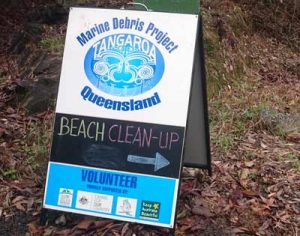Have you ever thought about volunteering at a beach clean up? Even World Heritage Listed areas like the Daintree need cleaning up so we went along to lend a hand and do our bit for the environment.
 Tangaroa Blue is a not-for-profit environmental organisation that coordinates beach clean ups and we recently spent the morning helping them collect, sort and count rubbish as part of a beach clean up at Cape Kimberley in the Daintree.
Tangaroa Blue is a not-for-profit environmental organisation that coordinates beach clean ups and we recently spent the morning helping them collect, sort and count rubbish as part of a beach clean up at Cape Kimberley in the Daintree.
And we were surprised at just how much rubbish we ended up collecting on the beach, particularly since at first glance it didn’t look like there was any litter at all.
Cape Kimberley lies on the north side of the Daintree River. It has little development and is many miles from large urban areas but yet it still suffers from littering caused by washed up marine debris from passing boats, trawlers and large ships.
The beach is visited every three months by Tangaroa Blue because the tides and currents regularly wash this unwanted rubbish onto the beaches of this supposedly pristine World Heritage Listed Area.
It’s thanks to organisations like Tangaroa Blue that travellers are still able to experience the area as nature intends it.
[headline size=”small” align=”left”]Getting started[/headline]
 On the day we joined the clean up there was torrential rain but there was still a good turn out at the allocated meeting point at 8.30am where we were briefed by Angie from Tangaroa Blue.
On the day we joined the clean up there was torrential rain but there was still a good turn out at the allocated meeting point at 8.30am where we were briefed by Angie from Tangaroa Blue.
She gave us a rundown of the day and what to do if we came across a needle, syringe or silver bottle containing dangerous aluminium sulphate (which is used to clean ships and required a 000 call).
Then it was time to zip up our raincoats, grab a pair of gloves and large rubbish bag and set off down the beach. Ignoring the wind and rain, we scoured the beach for anything that didn’t belong there.
[headline size=”small” align=”left”]Trashed[/headline]
 Getting involved in something like this is a real eye-opener because the range of rubbish we found washed up on the beach was astounding.
Getting involved in something like this is a real eye-opener because the range of rubbish we found washed up on the beach was astounding.
Some of the items we picked up included rubber thongs, shoes, bottle lids, glass bottles, plastic bottles, cigarette butts, straws, lollypop sticks, foam, cigarette lighters, pieces of balloon, tiny pieces of plastic, fishing lures, fishing line, fishing rods, rope, aluminium cans, plastic packaging, chip packets and pieces of glass.
Then there were the unusual items like bike reflectors, sardine tins, kid’s toys, balls, pens and textas, pill packets, plastic containers, small wheels and pieces of tyre.
And, given that we didn’t think the beach looked littered when we first arrived it makes you wonder just how much stuff we don’t notice.
The litter that we found had been washed up on a high tide and settled along the border of the beach and scrub.
[headline size=”small” align=”left”]processing[/headline]
 As each bag of rubbish was brought back to the checkpoint, the bag was weighed and the rubbish tipped onto a large makeshift table to be sorted.
As each bag of rubbish was brought back to the checkpoint, the bag was weighed and the rubbish tipped onto a large makeshift table to be sorted.
All of the volunteers stood around the table collating similar items such as bottle lids or pieces of glass, then we counted them and relayed the quantities back to one of the Tangaroa Blue team who logged it into a handheld data collection machine.
This information is added to Australia’s database on rubbish found at beaches around the country. This helps organisations like Tangaroa Blue work out which beaches receive the most amount of rubbish so they can plan which future areas to target.
[headline size=”small” align=”left”]Travel nq fast facts:[/headline]
- 633 species of wildlife are impacted by marine debris
- If you would like to find out more about Tangaroa Blue or volunteer to help at a beach clean up go to www.tangaroablue.org


